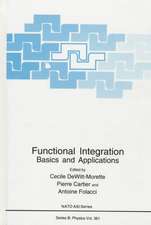Models for Physics of the Very Small and Very Large: Atlantis Studies in Mathematics for Engineering and Science, cartea 14
Autor Thomas J. Buckholtzen Limba Engleză Hardback – 27 mai 2016
Preț: 538.76 lei
Preț vechi: 633.83 lei
-15% Nou
Puncte Express: 808
Preț estimativ în valută:
103.09€ • 107.64$ • 85.13£
103.09€ • 107.64$ • 85.13£
Carte tipărită la comandă
Livrare economică 15-29 aprilie
Preluare comenzi: 021 569.72.76
Specificații
ISBN-13: 9789462391659
ISBN-10: 9462391653
Pagini: 382
Ilustrații: XII, 382 p.
Dimensiuni: 155 x 235 x 22 mm
Greutate: 0.73 kg
Ediția:1st ed. 2016
Editura: ATLANTIS PRESS
Colecția Atlantis Press
Seria Atlantis Studies in Mathematics for Engineering and Science
Locul publicării:Paris, Netherlands
ISBN-10: 9462391653
Pagini: 382
Ilustrații: XII, 382 p.
Dimensiuni: 155 x 235 x 22 mm
Greutate: 0.73 kg
Ediția:1st ed. 2016
Editura: ATLANTIS PRESS
Colecția Atlantis Press
Seria Atlantis Studies in Mathematics for Engineering and Science
Locul publicării:Paris, Netherlands
Public țintă
ResearchCuprins
Overview.- From data to the MM1 meta-model and MM1MS1 models.- From the MM1 meta-model to particles and properties.- From particles to cosmology and astrophysics.- From MM1MS1 models to traditional models.- From MM1MS1 models to traditional theories.- From the MM1 meta-model to perspective.- Appendices.- Compendia.
Textul de pe ultima copertă
This monograph tackles three challenges. First, show a mathematics-based meta-model that matches known elementary particles. Second, apply models, based on the meta-model, to match other known physics data. Third, predict future physics data. The math features solutions to isotropic pairs of isotropic quantum harmonic oscillators. This monograph matches some solutions to known elementary particles. Matched properties include spin, types of interactions in which the particles partake, and (for elementary bosons) approximate masses. Other solutions point to possible elementary particles. This monograph applies the models and the extended particle list. Results narrow gaps between physics data and theory. Results pertain to elementary particles, astrophysics, and cosmology. For example, this monograph predicts properties for beyond-the-Standard-Model elementary particles, proposes descriptions of dark matter and dark energy, provides new relationships between known physics constants (including masses of some elementary particles), includes theory that dovetails with the ratio of dark matter to ordinary matter, includes math that dovetails with the number of elementary-fermion generations, suggests forces that govern the rate of expansion of the universe, and suggests additions to and details for the cosmology timeline.
Caracteristici
Summarizes key findings Provides abstracts or introductory sentences - for chapters, sections, and subsections Uses tables to highlight key points Provides useful internal cross-references, including a list of abstracts for chapters and a list of abstracts and tables for sections Provides a mathematical basis for modeling known and possible elementary particles Provides ways to close gaps between physics data and traditional theory - in particle physics and cosmology Suggests extensions to the particle-physics Standard Model Provides an analog, for elementary particles, to the periodic table for elements Predicts measurable quantities Suggests new items and details for the cosmology timeline Points to opportunities for research in mathematics, applied mathematics, theoretical physics, and experimental and observational physics Is suitable for advanced undergraduate courses, graduate courses, and special-topics seminars Includes supplementary material: sn.pub/extras






















